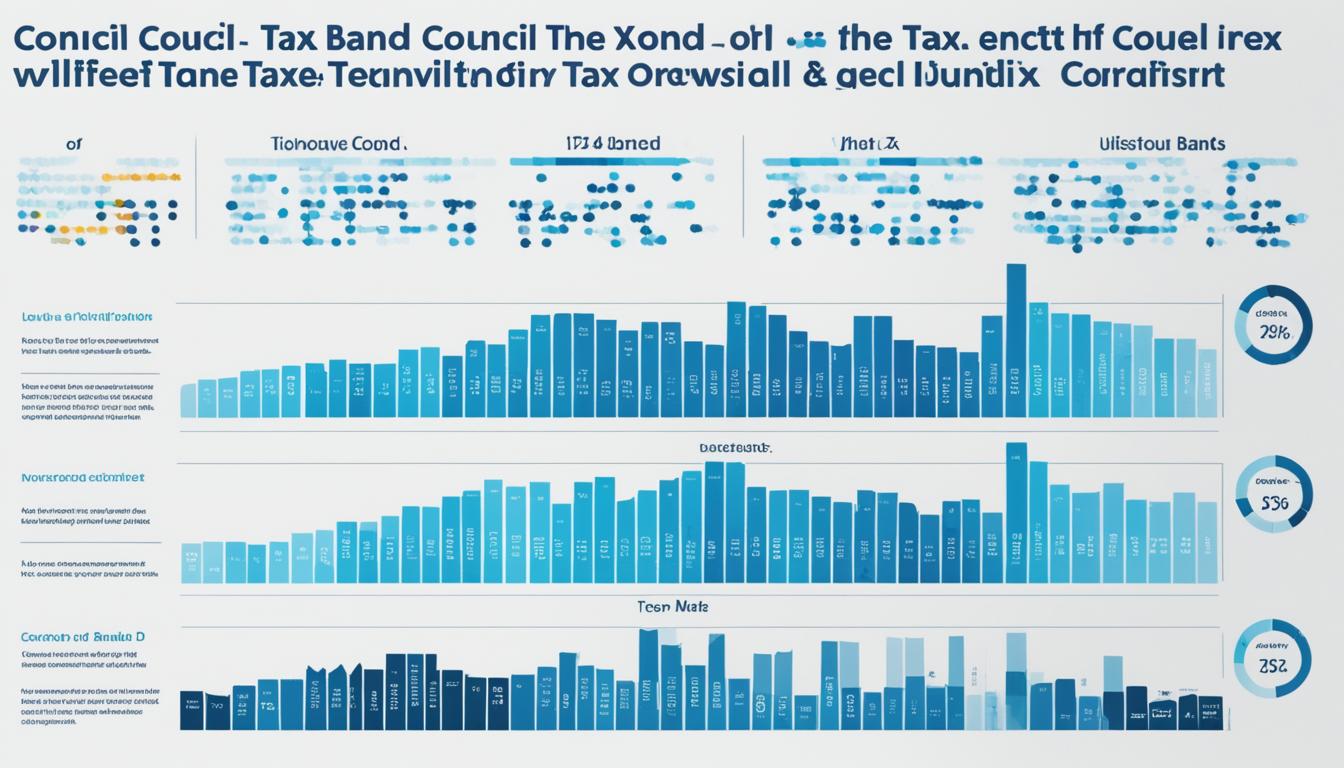Are you living in the UK and wondering about the ins and outs of Council Tax Band C? Look no further, as this complete guide will provide all the information you need. Council Tax is an unavoidable expense for UK residents, and understanding how it works and how much you may have to pay is essential. In this guide, we will delve into the details of Council Tax Band C, including how it is determined, what influences the rateable value, and the band valuation method. So, if you’ve ever asked yourself, “How much is Council Tax Band C in the UK?” or are simply curious about the intricacies of this particular tax band, keep reading!
What is Council Tax Band C?
In the United Kingdom, properties are assigned to one of several council tax bands based on their estimated market value. Council tax bands play a vital role in determining the amount of council tax a homeowner must pay to their local authority each year.
1. Council Tax Bands in England
In England, there are 8 council tax bands, labelled from A to H. Band C covers properties valued between £52,001 and £68,000 as of 1 April 1991, which was the reference date used for the initial property valuations. This band encompasses a significant portion of homes across the country.
2. Council Tax Bands in Wales
The council tax banding system in Wales is slightly different, with 9 bands ranging from A to I. In Wales, Band C covers properties valued between £65,001 and £91,000 as of 1 April 2003, the reference date for property valuations in the principality.
Regardless of the specific bands and their value ranges, the council tax band assigned to a property is a crucial factor in determining the annual council tax bill. Homeowners in Band C can expect to pay a moderate level of council tax compared to those in higher or lower bands.

| Council Tax Band | Property Value Range (England) | Property Value Range (Wales) |
|---|---|---|
| A | Up to £40,000 | Up to £44,000 |
| B | £40,001 to £52,000 | £44,001 to £65,000 |
| C | £52,001 to £68,000 | £65,001 to £91,000 |
| D | £68,001 to £88,000 | £91,001 to £123,000 |
| E | £88,001 to £120,000 | £123,001 to £162,000 |
| F | £120,001 to £160,000 | £162,001 to £223,000 |
| G | £160,001 to £320,000 | £223,001 to £324,000 |
| H | Over £320,000 | Over £324,000 |
| I | N/A | Over £444,000 |
Determining Your Council Tax Band
If you’re unsure about the council tax band assigned to your property, there are a few steps you can take to determine your band. Firstly, you can check the council tax bands of similar properties in your neighbourhood. If your home is comparable in size, age and style to neighbouring properties in the same band, this is a good indication that your band is correct.
Another approach is to estimate your property’s value from 1991 (England) or 2003 (Wales) using online tools. This can give you a rough idea of which council tax band your home would fall into based on its hypothetical sale value at the relevant valuation date. However, it’s important to note that the Valuation Office Agency (VOA) considers various factors when assessing a property’s band, not just its value.
Factors Considered in Band Assessment
When determining a property’s council tax band, the VOA evaluates a range of factors, including the size, layout, character, location and usage of the property. These elements help the agency estimate the hypothetical sale value of the home at the relevant valuation date, which ultimately determines the council tax band.
- Size of the property
- Layout and number of rooms
- Character and features of the home
- Location and desirability of the area
- Usage of the property (e.g. residential, commercial)
By understanding the factors considered in the council tax band assessment, homeowners can gain a better understanding of how their property’s value is determined and the potential grounds for challenging their band, if necessary.

Challenging Your Council Tax Band C
If you believe your property has been placed in the wrong council tax band, you have the right to challenge the banding decision. There are several acceptable reasons for initiating a council tax band challenge, including changes to the property since the original valuation, an error in the Valuation Office Agency’s (VOA) assessment, or evidence that the property was wrongly valued when the rating list was created.
To start the process of disputing your council tax band, the first step is to check with your neighbours to see if their similar properties are in the same band as yours. This can provide valuable insight into whether your property has been accurately assessed. You can then proceed to estimate your property’s historic value and submit a review request to the VOA or your local council.
- Check with Neighbours: Determine if properties similar to yours are in the same council tax band.
- Estimate Property Value: Research your property’s historic value to assess the accuracy of the current banding.
- Submit Review Request: Contact the VOA or your local council to initiate a formal review of your council tax band.
Remember, the key to a successful council tax band challenge is to have strong evidence that supports your case. By taking the time to thoroughly research and document the reasons for your appeal, you increase your chances of having your band reassessed and potentially lowered, resulting in significant savings on your council tax payments.
| Reason for Challenge | Example |
|---|---|
| Changes to the Property | Renovations, extensions, or structural changes that may have affected the property’s value |
| VOA Assessment Error | Inaccurate measurements, incorrect property characteristics, or a misunderstanding of the property’s condition |
| Incorrect Initial Valuation | Evidence that the property was wrongly assessed when the rating list was created |
By understanding the process of challenging your council tax band C and gathering the necessary evidence, you can take the first step towards potentially reducing your annual council tax payments. Remember, the council tax band challenge is an important tool for ensuring that you are paying a fair and accurate amount for the services provided by your local authority.

Discounts and Exemptions
If you’re unable to get your council tax band changed, there are several discounts and exemptions that may help reduce your council tax bill. Understanding these options can be a game-changer in managing your household finances.
1. Council Tax Discounts
One of the most common council tax discounts is the single-person household discount. If you live alone, you may be eligible for a 25% reduction on your council tax. This can provide significant savings, especially for those on a tight budget.
Additionally, full-time students are exempt from paying council tax altogether. This includes university students, as well as those in further education or training programs. Ensuring that your local council has the correct information about your student status can help you avoid unnecessary council tax charges.
2. Council Tax Exemptions
- Properties that are unoccupied due to the resident moving into a care home or hospital may be eligible for an exemption.
- Armed forces accommodation, such as barracks and military housing, are also exempt from council tax payments.
- Certain properties that are undergoing major renovations or repairs may qualify for a temporary exemption while the work is being carried out.
It’s important to note that the availability and specific criteria for council tax discounts and exemptions can vary across different local authorities. Contacting your local council is the best way to understand the options available in your area and ensure you’re receiving all the savings you’re entitled to.
| Discount/Exemption | Eligibility Criteria | Potential Savings |
|---|---|---|
| Single-Person Household Discount | Live alone | 25% reduction |
| Student Exemption | Full-time students | 100% exemption |
| Care Home/Hospital Exemption | Property unoccupied due to resident moving into care home or hospital | 100% exemption |
| Armed Forces Exemption | Armed forces accommodation | 100% exemption |
| Renovation Exemption | Property undergoing major renovations or repairs | Temporary exemption |
By exploring these council tax discounts and exemptions, you can potentially reduce your council tax bill and keep more of your hard-earned money in your pocket.

Conclusion
Navigating the complexities of council tax can be a daunting task, but by understanding the nuances of council tax band C, homeowners can ensure they are managing this household expense effectively. From recognising the property value range that defines band C to exploring potential discounts and exemptions, being an informed taxpayer is the key to managing council tax.
Whether you’re a first-time homeowner or have lived in your property for years, taking the time to review your council tax band and explore your options can lead to significant savings. By familiarising yourself with the assessment process and proactively addressing any discrepancies, you can understand council tax and ensure you’re paying the right amount.
Remember, staying informed and engaged with your local council is crucial in maintaining control over this ongoing financial commitment. By embracing the knowledge and tools provided in this guide, you can confidently navigate the world of council tax band C and make the most of your residential property ownership.
FAQ
1. What is Council Tax Band C?
Council Tax Band C represents properties with a market value between £52,001 and £68,000 in England (as of 1 April 1991) or between £65,001 and £91,000 in Wales (as of 1 April 2003). The council tax band determines the amount of council tax the homeowner must pay to their local authority each year.
2. How are Council Tax Bands Determined?
In England, properties are placed into one of 8 council tax bands (A-H) based on their market value as of 1 April 1991. In Wales, there are 9 council tax bands (A-I) based on property values as of 1 April 2003. The Valuation Office Agency (VOA) considers factors such as the size, layout, character, location and usage of the property to determine its hypothetical sale value at the relevant valuation date.
3. How Can I Check My Council Tax Band?
You can start by checking the council tax bands of similar properties in your neighbourhood. If your home is of a comparable size, age and style to neighbouring properties in the same band, this is a good indication that your band is correct. You can also estimate your property’s 1991 (England) or 2003 (Wales) value using online tools to estimate which band it would fall into.
4. Can I Challenge My Council Tax Band C?
If you believe your property has been placed in the wrong council tax band, you can challenge the banding decision. Acceptable reasons for a challenge include changes to the property since the original valuation, an error in the VOA’s assessment, or evidence that the property was wrongly valued when the rating list was created. To initiate a challenge, you should first check with neighbours and then estimate your property’s historic value before submitting a review request to the VOA or your local council.
5. Are There Any Discounts or Exemptions for Council Tax Band C?
Yes, there are various discounts and exemptions available that can reduce your council tax bill. Full-time students are exempt from paying council tax altogether. Single-person households can receive a 25% discount. There are also exemptions for properties that are unoccupied due to the resident moving into a care home or hospital, as well as for armed forces accommodation. Your local council can provide more information on the discounts and exemptions available in your area.




















No Comments
Leave a comment Cancel